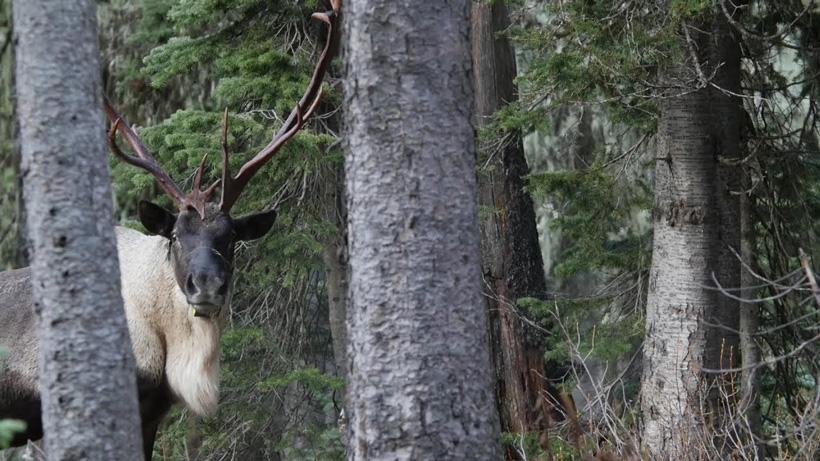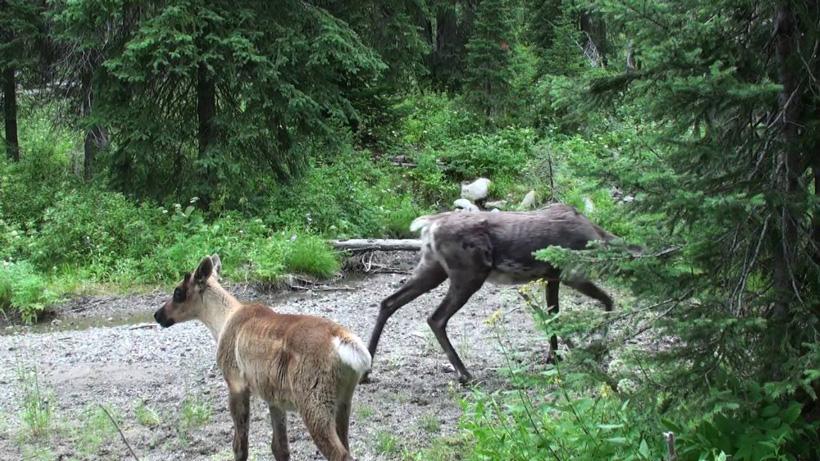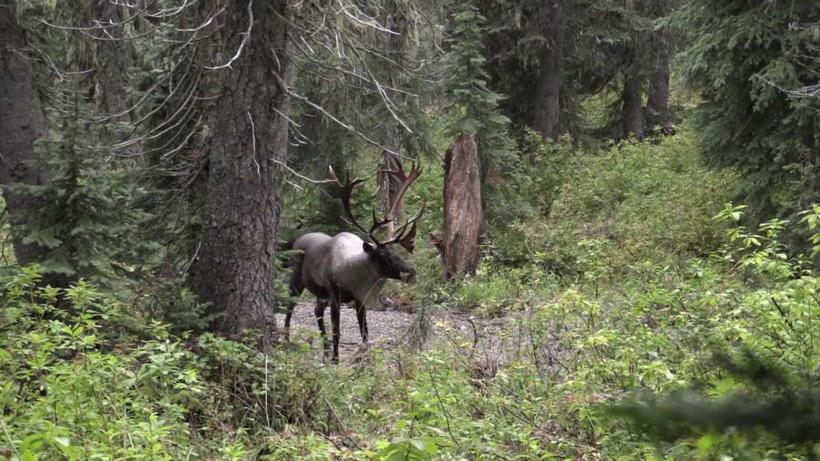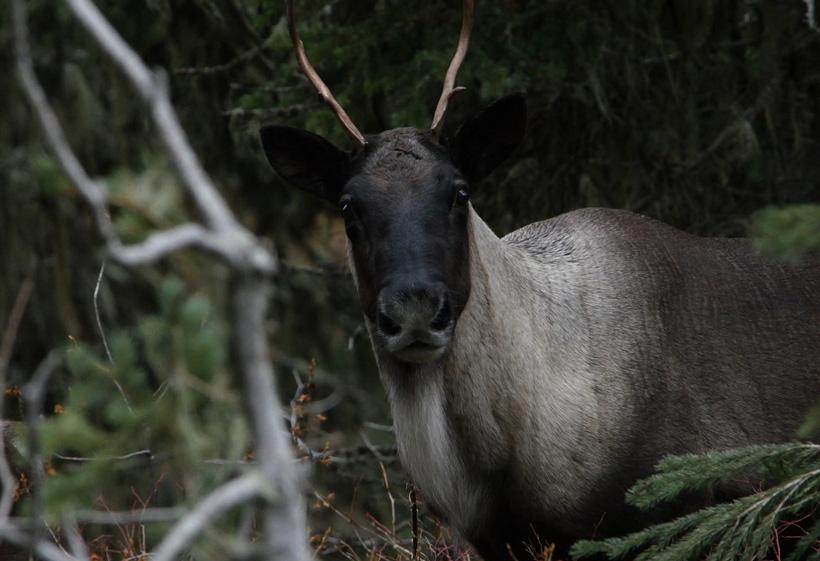




Caribou bull. Photo courtesy of Bryce Comer

Caribou cow and calf. Photo courtesy of Bryce Comer

Photo courtesy of Bryce Comer


Photo courtesy of Bryce Comer

Caribou bull. Photo courtesy of Bryce Comer
I was around 12 years old when I saw a picture of a caribou bull in a local newspaper from northern Idaho. Being a young kid, ripe with enthusiasm for my first hunting season, I quickly began scouring the article to learn about these beasts from the North. To say I was astonished to learn that a small population of these foreign animals was actually roaming my home state of Idaho would be an understatement.
From that point forward, I developed a deep fascination with these animals and dreamed of one day seeing them for myself in their natural habitat. The Selkirks of northern Idaho have since treated me to some incredible views, memories, and adventures, but glimpsing one of the ghost-like mountain caribou is still on my bucket list. Sadly, due to recent discoveries about these particular caribou, it is becoming wildly apparent that this may be the one goal and dream that will likely go unfilled in my lifetime.
The history and tragic downward spiral of the mountain caribou found in the southern Selkirk Mountain Range is as interesting as it is heartbreaking.
Mountain caribou can be dated back to prehistoric times and are known to have roamed the same tundras as other primitive creatures like woolly mammoths. Historically, populations of mountain caribou once ranged across northern Washington through Glacier National Park and down to the Salmon River of Idaho. While there are no official counts of how many caribou were once present in the Lower 48, it is commonly accepted that the species likely numbered in the hundreds in the late 1800s. In 1888, Theodore Roosevelt actually commissioned a hunting trip and successfully harvested a Selkirk Mountain caribou near Kootenay Lake in British Columbia.
The current range of these animals has been reduced to a small section of the southern Selkirk Mountain Range found in southern British Columbia (BC), eastern Washington and Northern Idaho.
It was roughly estimated that anywhere from 25 to 100 animals remained from 1925 until the 1980s when conservation and animal populations really began being closely monitored. Populations ranged from 33 to 51 animals from 1991 until 2009. During this time frame, biologists also supplemented the herd with transplanted caribou from northern BC though these relocations were mostly unsuccessful. The biggest drop in herd numbers was recorded from 2009 through 2013 when the herds dropped from 46 to only 12. This time frame is also largely in line with the wolf reintroductions of the West. The southern Selkirk Mountain caribou were officially listed as an endangered species in the contiguous US in 1984.
As of March 2017, a total of 11 caribou were counted and, with the 2018 count on the horizon, biologists are obviously anxious to see how the herd had wintered. Unfortunately, at the time of this writing, only three cows are thought to be remaining. Biologists are unsure at this point if any of the cows are pregnant—a fact that could lead to the discovery of undocumented bulls in the area. The fate of the species is in serious trouble.
Several attempts have been made to augment herds with mountain caribou from northern BC, but each attempt has been thoroughly unsuccessful. The northern counterparts to the Selkirk Mountain caribou are not adapted to living and surviving in the same temperate rainforest climates nor are they adequately adapted to efficiently digest the same vegetation. This eventually led to massive winter die-offs and, in one particular case during the 1980s, 18 of 19 transplanted caribou died.
Caribou cow and calf. Photo courtesy of Bryce Comer
Another nail in the coffin for the declining caribou can also be found in their reproduction traits. In recent years, the yearly calf recruitment rates have dropped to an average of 9.9%, falling short of the necessary 12% to 15% that is required for stable herd health.
In an effort to boost calf counts, maternal pens have been built with high fences and supplemental feeding to meet nutritional needs and provide predator protection. However, due to heavier snowfalls during this current season, a vital maternal pen has been buried and destroyed, leaving any potential calves totally unprotected from predation.
Before exploring what elements are causing the decline in caribou, it is first important to understand how these unique animals use their habitat and what evolutionary traits are at work. Mountain caribou of the Selkirk Range inhabits what is considered a temperate rainforest. These areas can be loosely classified as landscapes consisting of heavy tree cover, lots of yearly precipitation, dense vegetation and predominantly comprised of old growth forest. Most of the moisture in the Selkirk Range is attributed to snowfall and heavy snowpack is critical to caribou health.
Photo courtesy of Bryce Comer
Normally, when we as hunters think of traditional winter grounds, we imagine wide valleys with low snow levels and an ample availability of native grasses and browse. While this is mostly true for deer, elk, and moose, the mountain caribou spends their winter months close to alpine levels and live off of arboreal lichen, a plant that is extremely easy to digest, but is not notably high in nutritious value. Thanks to their unique hooves, caribou can thrive in elevations exceeding 5,000 feet and in areas with as much as 12 feet of snow. These hooves act as natural snowshoes and allow the animals to reach the vital lichen that would otherwise be unavailable if the high snow levels were not present.
These unique wintering grounds have traditionally kept most predators at bay and given caribou moderately easy conditions during years of good snowfall. During periods of extremely heavy snowfall, the lichen can actually become buried and will eventually die off leading to a lack of crop for several following years. Conversely, during years of light snowfall, caribou are unable to reach lichen and are forced to forage on less digestible foods. It’s a fine balance of life and well being in a formidable country.
Recently, climate change concerns have worried biologists and have been to blame for some of the herd’s decline. Later occurring winters and earlier springs have robbed these temperate rainforests of vital moisture and areas throughout the caribou’s range are becoming drier than historically recorded. Additionally, with current forest fighting procedures, wildfires have led to serious habitat loss in some regions. These fires have destroyed old growth forests vital to proper lichen growth and moisture retainment.
With the rapid decline in Selkirk caribou numbers—particularly in the last ten years—everyone’s thoughts are currently heading in the same direction: What is going on? While caribou do live in the wild and death can come in many forms, the bulk of the decline among Selkirk caribou can be directly linked to loss and change of habitat, highway fatalities and predation.
Because of the caribou’s peculiar living patterns, any changes in habitat—both human-caused and natural—can have an enormous impact on the survivability of the region’s herd. As we touched on earlier, climate change has led to shorter winters in much of the Rocky Mountain Range. Because of this, we are experiencing drier conditions than in years past and are seeing far less available feed and valuable lichens that are vital to winter survival. While the decline in the available feed is a notable worry, perhaps the biggest sign of change that has hurt the caribou is logging and, in particular, the logging of old growth forest.
Without diving too far into a rabbit hole I believe it should be noted that, in general, logging is a very healthy and productive practice for nearly any environment. Browsers such as deer, elk, and moose benefit greatly from an increase of leafy plants and native grasses and the forest itself benefits from an increase of available sunlight and reduction in ground fuels. However, for caribou, logging drastically reduces their food supply.
The problem for caribou really arises within the traditional wintering characteristics of the aforementioned species. For the most part, the caribou have always wintered near timberline while most other ungulates spend their winters in low lying valleys where the lowest snow depths are found. Now, with access to available feed typically present throughout clear cuts in a multitude of elevations, ungulates such as deer, elk and moose can be found wintering in areas much higher than historically recorded. While the influx of new animals isn’t an immediate threat, the predators that follow them are.
Beyond logging, other major industrial activities like mining, power lines, and gas lines have all attributed to a higher predator count in the high country. Access into some of the most remote country is now as easy as ever.
All animals have coexisted with predators for thousands of years. This is a fact that can be said for prehistoric dinosaurs and will still be true a thousand years from now. Mountain lions, black bears, and grizzly bears have always been present in the caribou’s history though predation from these animals has been generally unconcerning. With the reintroduction of wolves, predation of all animals greatly increased and caused a massive paradigm shift in animal activity. Herds of elk, deer, and moose began seeking areas away from wolf packs during crucial winter months, which, eventually, led to them to new growth vegetation found in logging clear cuts. This gradual movement increased in elevation and the safety gap between the caribou and other wintering animals began to dwindle. Soon, the new dominant predator of the landscape discovered a new food source in the caribou; two animals that historically have had very little interaction.
After it became apparent that wolves were posing a huge threat to the population of Selkirk caribou, Canadian officials decided to initiate an aggressive and controversial wolf cull. To do this, government officials would hunt the wolves with the use of helicopters. Due to the difficulty of the terrain and incredibly thick vegetation found in the Selkirks, the culls have been falling below initial objectives. While the actions have certainly slowed the predation to some degree the major damages have already been done and will likely never be stopped.
Perhaps one of the most debated subjects along the recovery efforts for the Selkirk caribou herds lies in the recreational activities of the public, primarily in snowmobile use. Snowmobilers are often times looking for the deepest power and steepest terrain they can find. Coincidently, this is also the type of areas that are typically used by mountain caribou for wintering grounds. The increase of wintertime recreation will lead to increased stress on the animals at a time where every ounce of energy is needed. Additionally, a surprising number of predators were found to also use the pack tracks of the snowmobiles to access the high country.
This has led to the attempted closure and protection of many of these areas though it has been an uphill battle for biologists. In 2012, the Fish and Wildlife Service proposed the closure and designation of 375,000 acres of caribou wintering areas within Idaho, Washington, and British Columbia. After massive opposition to the plan, officials were forced to reduce the closures to a mere 30,000 acres. Additionally, at the time of the proposals, the Pacific Legal Foundation, which represented the Idaho Snowmobilers Association, petitioned the federal government to delist the 12 remaining mountain caribou from the endangered species list. Their argument was based on the grounds that there are other mountain caribou found in northern Canada and that there is no genetic separation between northern herds and the animals found in the Selkirks.
Unfortunately, at this point, it seems as though we may have arrived at the proverbial “too little, too late.” Conservation efforts of these great species have been started, but the species is already in major decline and funding from wildlife agencies is largely funneled toward higher-profile animals like wolves and grizzly bears. Biologists have been working tirelessly to save the species, but the long terms effects of habitat loss have been crippling and are very likely irreversible.
In my opinion, there has simply been far too much focus on the economic gains to be made on a land full of resources and very little thought or worry as to the condition of native wildlife. It seems as though the fate of the Selkirk Mountain caribou has been written off by most officials.
Photo courtesy of Bryce Comer
While the possibility is still there that the three remaining cows have been impregnated, the unfortunate truth is that the odds of survival for this population is dismal at best. In a current world of self-preservation, recycling, and awareness, it seems that the Selkirk Mountain caribou was simply forgotten. The matter of fact is that the loss of this herd is one of the greatest examples of poor management and blindness due to the greed of any conservation effort in modern times.